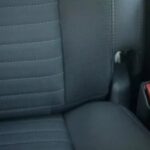Scratches on your car console can be an eyesore, detracting from the overall interior appeal of your vehicle. Whether they are light surface abrasions or deeper gouges, these imperfections can make your car’s interior look worn and neglected. Fortunately, repairing scratches on your car console is a manageable DIY task, especially for deeper scratches that require filling and repainting. This guide will walk you through a method to effectively restore your car console to its former glory.
Preparing the Scratched Car Console
For deep scratches, removing the plastic console panel from your car is highly recommended. This allows for better access to all angles and surfaces, making the repair process significantly easier and more effective. Detaching the panel provides a stable and maneuverable workspace. However, if removing the panel is not feasible, thorough preparation is still possible. Use automotive masking tape to carefully protect the surrounding areas, such as wood trim, leather, or vinyl, ensuring they remain free from any repair materials or accidental damage.
Alt text: Close-up of scratches on a car console, highlighting the damage before repair.
Before starting the repair, it’s essential to prepare the scratched area properly. Begin by using a razor blade to carefully trim away any plastic burrs or protruding fragments around the scratch. This step ensures a smooth surface for sanding and prevents further damage during the repair process.
Smoothing Out the Damage
Next, sanding is crucial to create a smooth base for the filler. Use sandpaper to gently sand down the scratches and the surrounding area. The goal is to even out the surface and create a key for the filler to adhere to. Be careful not to apply excessive pressure, as this could worsen the damage or alter the texture of the console.
Alt text: Hand sanding scratches on a car console with sandpaper to smooth the surface for repair.
Cleaning the Console Surface
After sanding, thorough cleaning is necessary to remove any sanding debris and contaminants. Spray a car interior cleaner onto a clean microfiber towel. Gently rub the treated towel onto the sanded surface of the plastic console panel. This will effectively lift away any loose particles, dirt, and grime. Once cleaned, use a fresh, dry microfiber towel to wipe off any remaining cleaner residue, ensuring a pristine surface ready for the next steps.
Crafting a Grain Pad for Texture Matching
To seamlessly blend the repair with the original console texture, creating a grain pad is a smart technique. Start by spraying a small section of the console panel with a surface sealant and protectant. This step is crucial as it prevents the hot glue from permanently bonding to the console surface.
Then, take a hot glue gun and apply hot glue to a separate piece of plastic, slightly larger than the scratched area you are repairing. Immediately press the glued side of this plastic piece firmly onto the section of the console you’ve treated with sealant. Allow the glue to dry completely. Once dry, carefully peel off the plastic piece. If done correctly, the texture imprinted on the glued side of the plastic will mirror the factory grain pattern of your car console. This custom-made grain pad will be instrumental in replicating the original texture during the filler application.
Alt text: Close-up showing the process of creating a grain pad using hot glue and a textured car console surface to replicate the grain.
Applying Filler and Restoring the Grain
Now, apply a thin, even coat of body filler putty directly onto the scratched area of the console. Use a razor blade or a similar spreading tool to carefully distribute the filler, ensuring it fills the scratch completely and levels with the surrounding console surface.
While the filler putty is still drying and pliable, take the grain pad you created earlier and firmly press the textured side onto the puttied area. This imprints the factory grain pattern onto the filler, seamlessly integrating the repair with the original texture. Allow the filler putty to dry completely according to the manufacturer’s instructions.
Alt text: Applying body filler to car console scratches and using a custom grain pad to imprint texture onto the wet filler.
Final Touches: Painting the Repaired Console
Once the filler is fully dried and hardened, the final step is painting. Spray the entire plastic console panel with a car interior paint that perfectly matches the original color of your console. Apply thin, even coats, allowing each coat to dry before applying the next. This prevents runs and ensures a smooth, professional finish. Once the paint is completely dry, your car console scratch repair is complete, and the console should look as good as new.
Alt text: Finished and painted car console scratch repair, showing a seamless texture and color match.

